
Germany - Germany - tram-trains
Karlsruhe area tram-train system
For a full scale picture, please click on the picture shown !
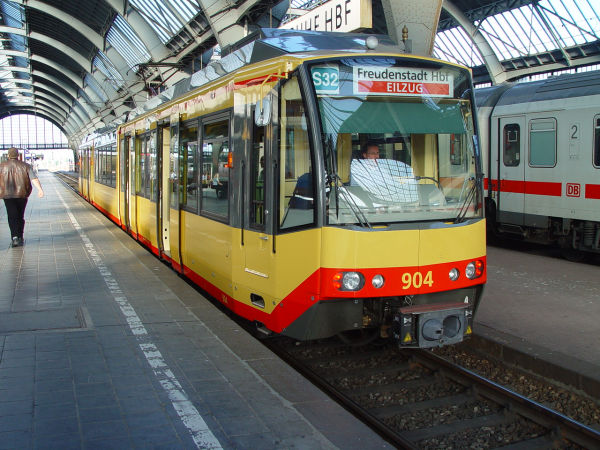
Karlsruhe in Germany was one of the first cities to introduce a so called
tram-train lightrail service. Karlsruhe has a tram network, which has the same gauge width as normal trains (1435 mm). They
built special trams, which can run on both trains' AC electricity as well as trams' DC electricity and which have the safety
systems of both. In downtown they can run on the streets as trams and then they can run longer streches on train tracks.
At Karlsruhe main station you can encounter these tram-trains both inside the station at the train platforms as well as outside
by the tram platforms on the street.
There are three operators of tram-trains in Karlsruhe, DB (four tram-trains) and AVG, Albtal-Verkehrs-Gesellschaft, a company
owned by the city, as well as KVV, the Karlsruhe-Verkehrs-Vertriebe, the city tram service department.
This is an AVG tram-train of the type GT8-100D/2S-M built 1997-2005 by Bombardier. It is of the second generation of tram-trains
in Karlsruhe. Picture at Karlsruhe Hauptbahnhof 20.7.2004 by Ilkka Siissalo.
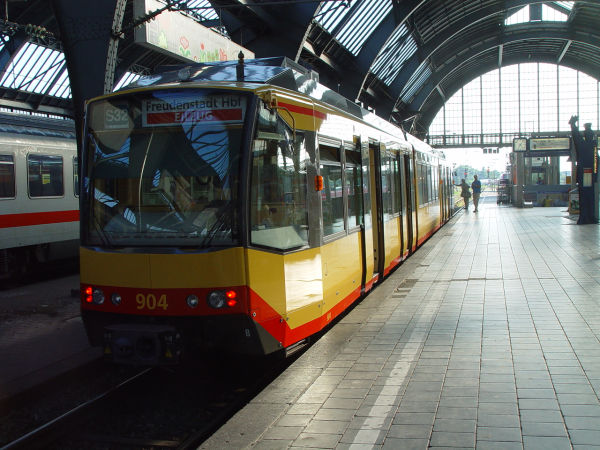
This is the same tram-train as above, but seen from the other end. They have similar driver's cabs at both ends to allow them to
neatly turn around at small train stations far away from the city. Picture at Karlsruhe Hauptbahnhof 20.7.2004 by Ilkka Siissalo.
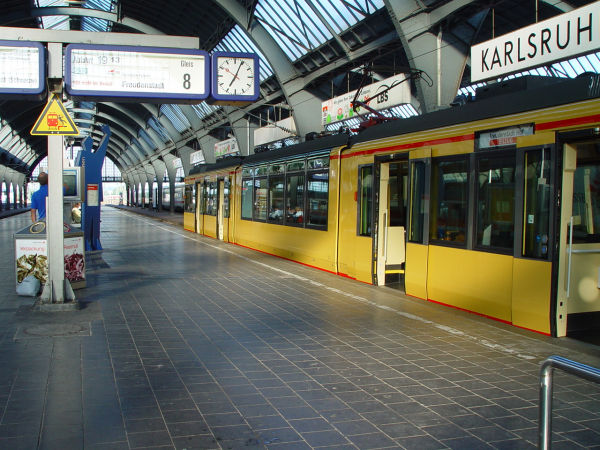
Side view of the same tram-train. Picture at Karlsruhe Hauptbahnhof 20.7.2004 by Ilkka Siissalo.
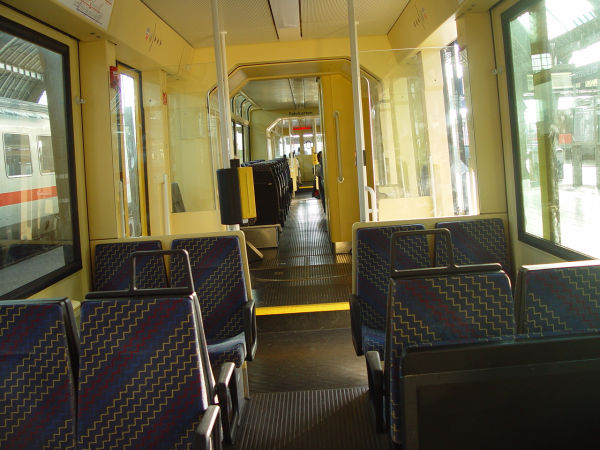
Inside view of the same tram-train. Picture at Karlsruhe Hauptbahnhof 20.7.2004 by Ilkka Siissalo.
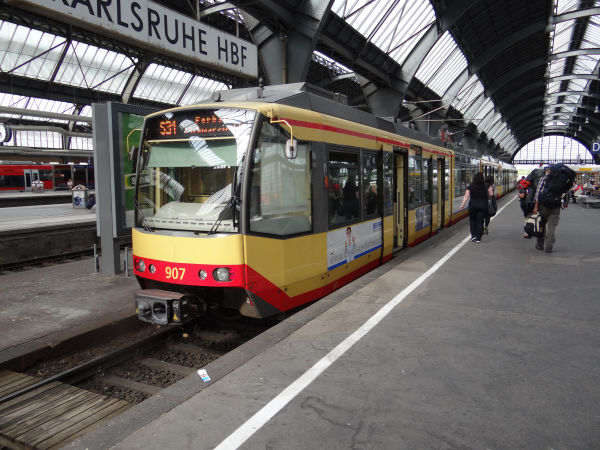
A two units long tram-train of the S31 service. Picture at train platforms of Karlsruhe Hauptbahnhof 8.7.2015 by Ilkka Siissalo.
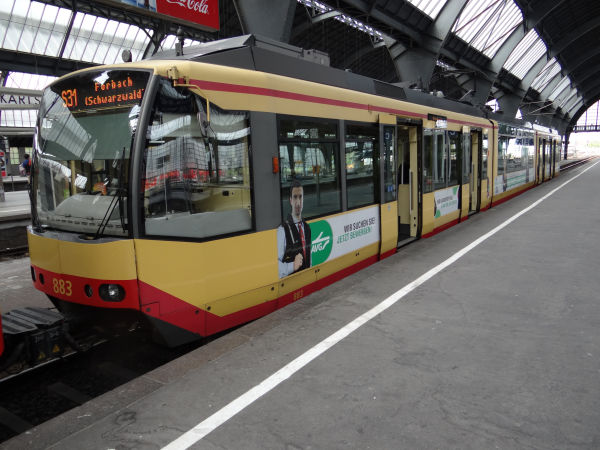
AVG unit no.883. This was the second unit of the same tram-train as in the picture above. Picture at train platforms of
Karlsruhe Hauptbahnhof 8.7.2015 by Ilkka Siissalo.
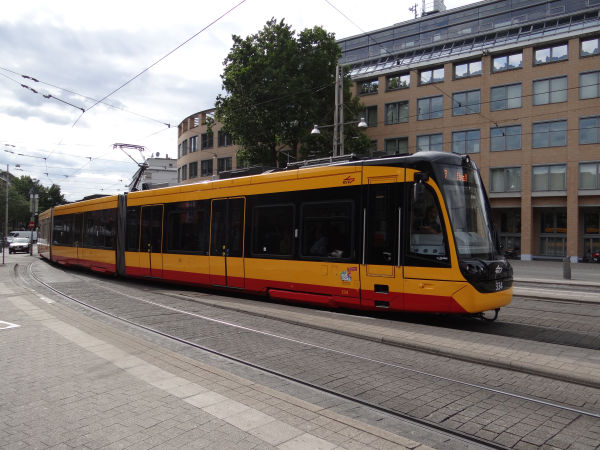
This is a CityLink tram of the KVV, the Karlsruhe city tram company. It is a NET 2012 type tram made by Vossloh in 2015
and it is also authorised to run on train tracks at the Albtalbahn, although here it is used as a normal tram.
Picture at tram platforms of Karlsruhe Hauptbahnhof 8.7.2015 by Ilkka Siissalo.
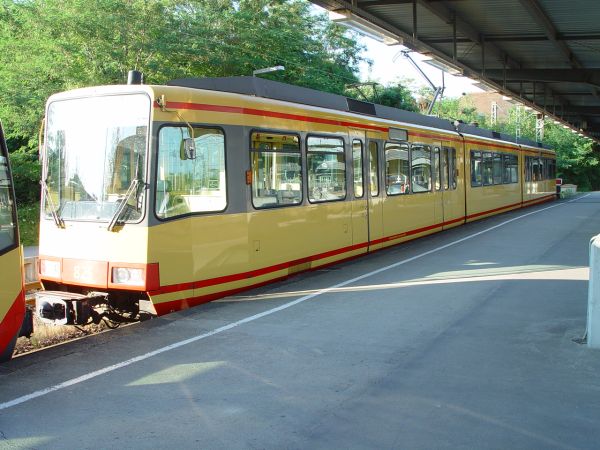
This was the very first generation of Karlsruhe's tram-trains, registered as a train of Baureihe 450. DB owned a couple of these and the Karlsruhe city's
transport authority VBK (Verkehrsbetriebe Karlsruhe) the rest of them.
Picture from Karlsruhe Hauptbahnhof 20.7.2004 by Ilkka Siissalo.
Tram-trains of Nordhausen
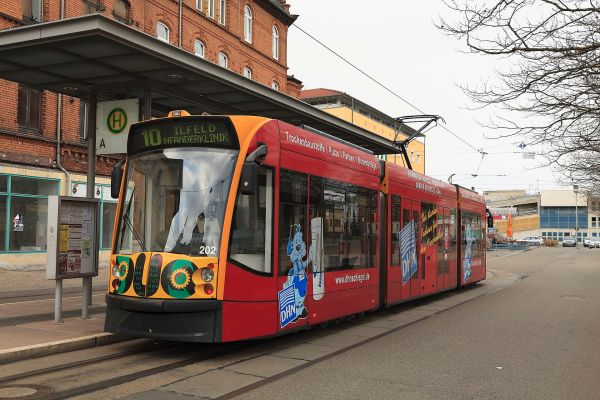
Nordhausen's newest, third tram line no.10 is kind of exotic. It runs from Nordhausen to the town of Ilfeld using mostly the narrow gauge train tracks of
Harzer Schmalspurbahnen HSB's trains. On those lines no catenary wires exist. For this purpose three Siemens Combino Duo trams have been ordered which have in
their middle section a small diesel engine allowing them to operate on the train line.
Picture from Nordhausen Bahnhofsplatz 15.4.2012 by Wikimedia user "Falk2". Published under the Creative Commons
CC BY-SA 4.0 license.
For more pictures of Nordhausen's trams, see our section of Trams, subtitle Nordhausen
Stuttgarter Strassenbahn SSB - Stuttgart area light rail U-Bahn
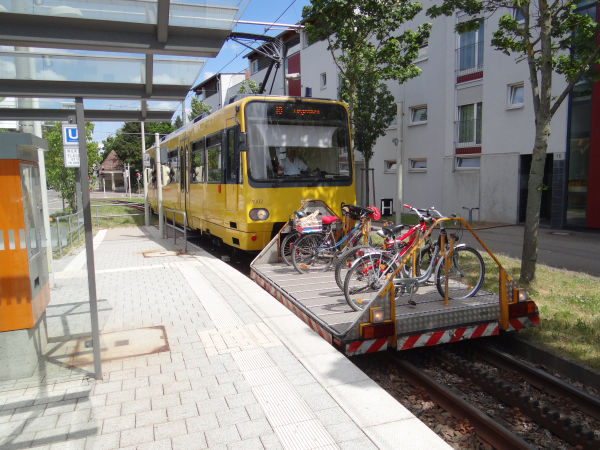
It's difficult to say if this is a tram or a train, but anyway it's for sure one of the most interesting German light rail
systems. This is the line 10 of SSB, Stuttgarter Strassenbahnen AG, the city of Stuttgart tram company. The line nicknamed
"Zacke" climbs very steeply uphill from Stuttgart city to Degerloch with the help of a cog wheel third rail system. The line was opened
in 1884, first with cog wheel steam locomotives, which pushed three coaches up the hill. The four axle wagons
still in use came into service in 1984 at the centennial birthday of the line. However newer trains have been ordered at the time
when this was written in 2022. At least one new train has already been delivered. All these pictures here dated in the year 2015
were taken at a time when the lower station was still at Filder Bahnhof. Currently a part of the line has been rebuilt and
the tram-train starts now from Marienplatz in the city centre.
Picture from Stuttgart 8.7.2015 by Ilkka Siissalo.
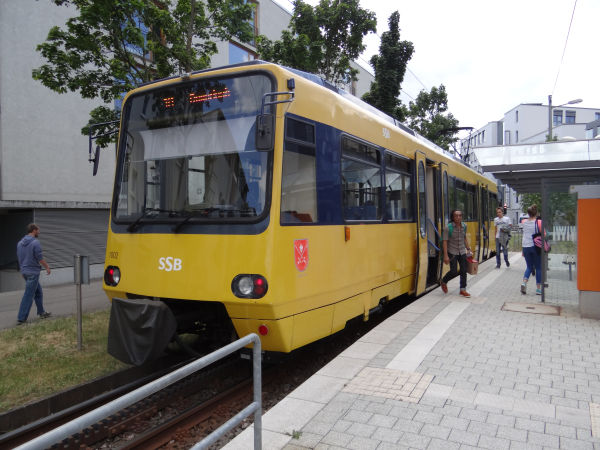
Another picture of the SSB wagon 1002 on line 10.
Picture from Stuttgart 8.7.2015 by Ilkka Siissalo.

Yet a third picture of the same wagon. The rails are of metre gauge and the cog wheel racks are of the system Riggenbach.
This is the only cog wheel rack rail system in metropolitan use in Germany. The maximum incline of the rail line is 17,5%.
This rack rail train is a famous tourist attraction in Stuttgart. The train operates with 750V DC, originally with 600V.
Picture from Stuttgart so called Filder Bahnhof 8.7.2015 by Ilkka Siissalo.
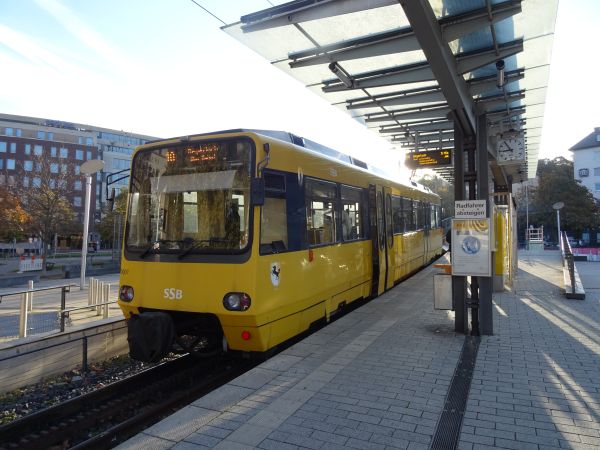
Still one of the 1980s trains but now at the new lower end station of the line at Marienplatz in the city center.
Picture from Stuttgart Marienplatz 6.11.2022 by Ilkka Siissalo.
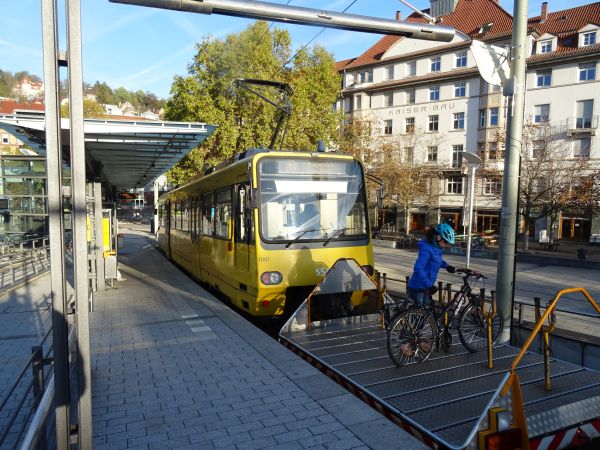
Loading a bike onto the platform wagon which the train pulls then uphill to Degerloch. Loading and unloading of bikes is only
allowed at the end stations, not during the times when the train stops in between at the several tramstops along the line.
The new trains which are to arrive soon will have also new bicycle wagons which can take about three times more bikes as these
1980s wagons can.
Picture from Stuttgart Marienplatz 6.11.2022 by Ilkka Siissalo.
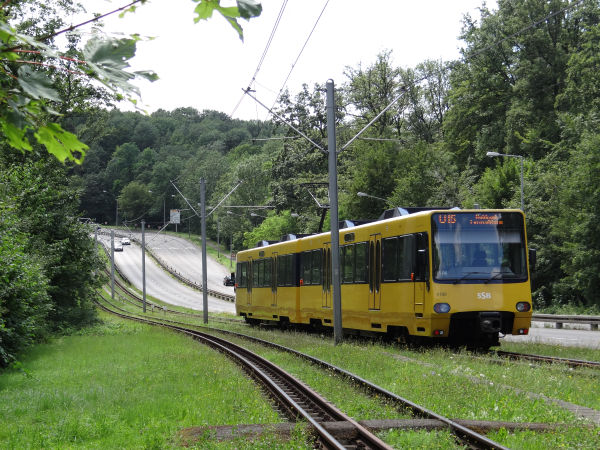
Stuttgart has also other interesting rail services. This is the U-Bahn light rail line U15 service at the stop
Stelle (Stelle = place in German, but yes, it is the name of the stop). Note the three rail system allowing also a narrow gauge
train to run on the same track.
Picture from Stuttgart Stelle 8.7.2015 by Ilkka Siissalo.
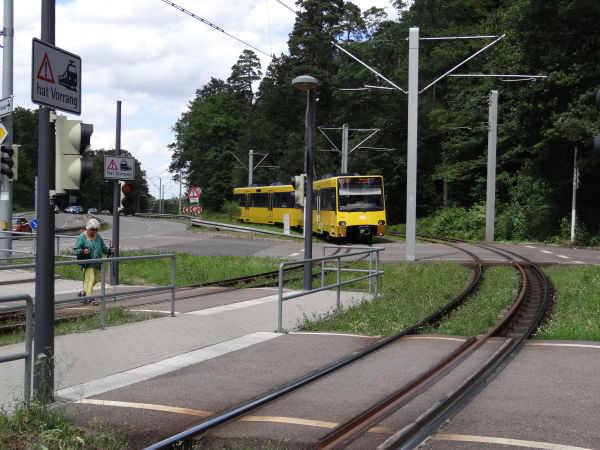
A real kamikaze suicide candidate, this lady was actively trying to get run over by the Stuttgart U15 line light rail
in spite of several warning signs, a blinking red light and an acoustic signal. She wasn't hit, but it was a narrow escape.
Picture from Stuttgart Stelle 8.7.2015 by Ilkka Siissalo.
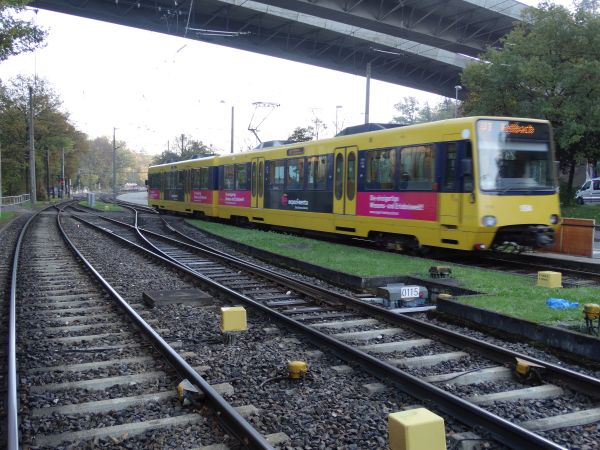
One of the same type U-Bahn trains of Stuttgart. It's hard to say should one consider these to be metro trains, trams or full trains.
In a way they could be classified as all of the above. But legally speaking they are treated as trams.
Picture from the U-Bahn stop Vogelrain 6.11.2022 by Ilkka Siissalo.

